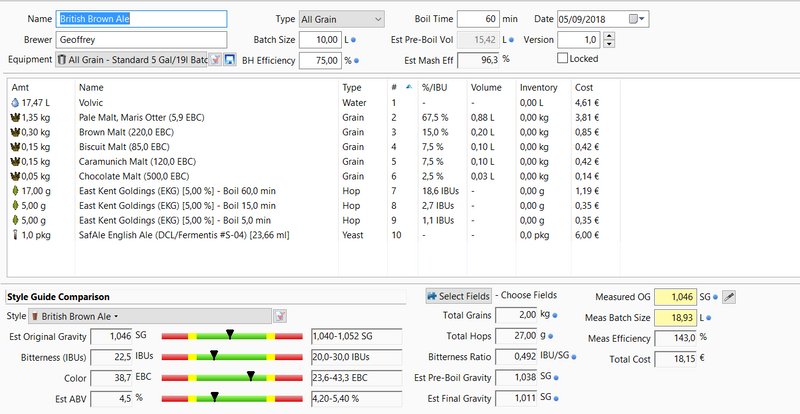Geoffrey006
Member
- Joined
- Sep 5, 2018
- Messages
- 19
- Reaction score
- 1
Hi guys,
What do you think of this BBA recipe ?

Thank you
What do you think of this BBA recipe ?

Thank you



![Craft A Brew - Safale S-04 Dry Yeast - Fermentis - English Ale Dry Yeast - For English and American Ales and Hard Apple Ciders - Ingredients for Home Brewing - Beer Making Supplies - [1 Pack]](https://m.media-amazon.com/images/I/41fVGNh6JfL._SL500_.jpg)










I wouldn't use Brown Malt in either, but if anything I'd say it is less appropriate in British Brown Ale than American Brown Ale, as you sometimes find strong roasted flavor in examples of the latter.I'm a bit confused, are we talking about American brown ale or British brown ale ?
I'm not sure I'd count on a compilation of brewersfriend user recipes for the final say in British beer styles, tasty though they may be. I'd try to find a Brit -- maybe one will chime in here. Failing that, I'd check the BJCP guidelines. The first sentence for the style says,My goal is to make a british brown ale, and from what I saw the brown malt is a common grain to add (here it's the 6th most used grain: https://www.brewersfriend.com/styles/british-brown-ale/)
Special Roast is nothing at all like Brown Malt. Special Roast is a kilned malt, similar to Biscuit Malt or Victory Malt, or Honey Malt (all of which are great additions to Brown Ale). Special Roast imparts a biscuity maltiness and a bit of sweetness, not the dry roasted flavor of Brown Malt.I did a quick google and BYO mag has a northen english brown
https://byo.com/article/northern-english-brown-ale-style-profile/
it uses special roast which is briess' attempts at making English brown malt. It would be a straight sub. Victory is not english but i really like it in a brown.
Well, Briess' own website calls it "roasted malt", though in their description they make it clear it's more of a biscuit-type malt:My bad, I'm sure I read somewhere on this forum that special roast was breiss' equivalent and that you could sub.
It was some time ago and I didn't specify in my notes, but it was certainly an English maltster -- probably Crisp or Bairds.May I ask what maltster you are using for your brown malt. The fact that you say when adding chocolate malt for color it came out too roasty is suprising to me. Either you using a maltster with signficantly more assertive roasting than I am used too or your very sensitive to roasted character.
I'm a bit confused, are we talking about American brown ale or British brown ale ?
My goal is to make a british brown ale, and from what I saw the brown malt is a common grain to add (here it's the 6th most used grain: https://www.brewersfriend.com/styles/british-brown-ale/)
All I've ever seen in the US is Newcastle (bottled and kegged) and Sam Smith's (bottled). The closest I've gotten on my few trips to England has been a watery mild or two.
My CAMRA-member friends all scoff at Brown Ale, having only encountered adjunct-laden bottled versions. What I (and probably many Americans) think of as "Brown Ale" would probably get called "Strong Mild" in the UK.
Brewersfriend is wrong - brown malt has no part in British brown ales. You have to remember that they're fundamentally a relative of the bitter/pale mild family, rather than the porter/stout family - indeed historically most British brown ales were just a bottled version of a brewer's bitter/mild with some caramel in it.
Also you have to work out what kind of brown ale you're trying to make - and that doesn't include "northern brown ale" which is something Michael Jackson invented and which BJCP have sensibly ignored since 2015. But arguably you could say that there are three types, London brown ale, single brown ale and double brown ale. Mann's is the obvious example of the former, it used to be advertised as the sweetest beer on the market and is very much a competitor for milk stout. The 1958 Younger's is an example of the second - 60:30:10 pale:flaked maize:sugar to 1.031 and 83% attenuation, presumably with some caramel for colour. Many had a bit less flaked maize, or subbed some/all for flaked barley, and 3-7% crystal was pretty common. Then Whitbread Double Brown was pale malt with 16% invert #3 and 1% chocolate at 1.053 and 72% attenuation.
Then you have Newcastle Brown which is one of those benchmark beers that is something of an outlier for its style ,and is made completely differently being a blend of old and new beer.
Anyway - it depends what style you're going for. But keep it simple, these are cheap, uncomplicated beers - and don't use brown malt.
Do you have access to Carafa malts from Weyermann? If so, replace (or augment) the Chocolate Malt with enough Carafa III (de-husked if possible) to hit your color target. The Carafa adds a lot of color with only very mild additional roast flavor.The problem is that with 83.5% maris otter, 9% Caramunich, 5% Biscuit and 2.5% Chocolate, my color is at the low low range of the EBC for a Brit brown ale. I reach only 24 EBC, and ideally I would have like 30.
The problem is that with 83.5% maris otter, 9% Caramunich, 5% Biscuit and 2.5% Chocolate, my color is at the low low range of the EBC for a Brit brown ale. I reach only 24 EBC, and ideally I would have like 30.